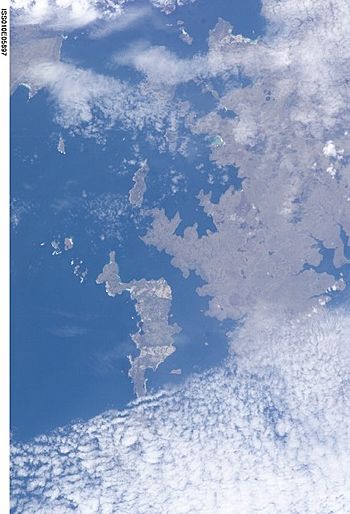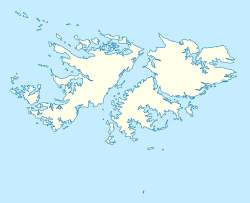Speedwell Island facts for kids
|
Isla Águila
|
|
|---|---|

Satellite photo with Speedwell Island just below and to left of center
|
|
| Geography | |
| Location | Atlantic Ocean |
| Coordinates | 52°13′10″S 59°43′00″W / 52.21944°S 59.71667°W |
| Archipelago | Speedwell Island group |
| Area | 51.5 km2 (19.9 sq mi) |
| Length | 17.5 km (10.87 mi) |
| Width | 5 km (3.1 mi) |
| Administration | |
|
Falkland Islands
|
|
Speedwell Island is one of the Falkland Islands. It used to be called Eagle Island. In Spanish, its name is Isla Águila. This island is located in the Falkland Sound, southwest of Lafonia, which is part of East Falkland.
Speedwell Island covers an area of about 51.5 square kilometers (20 square miles). It is about 17.5 kilometers (11 miles) long from north to south. At its widest point, it is about 5 kilometers (3 miles) across. The island is mostly flat and has some small ponds that are always there.
It is separated from Lafonia by a narrow waterway called the Eagle Passage. This passage keeps the island's old name alive. Speedwell Island is the biggest island in its group. Other islands in this group include the Elephant Cays, George Island, Barren Island, and Annie Island.
Contents
Amazing Animals and Nature
Speedwell Island is one of the largest islands in the Falklands that does not have rodents. This is great for the local wildlife! Many native songbirds, seabirds, and penguins live and thrive here. More than 40 different types of birds have been seen on the island.
A large group of South American sea lions lives nearby in Speedwell Pass. About 90 sea lion pups are born there every year. These sea lions often come ashore on Speedwell Island and other islands in the group. For over 100 years, the island has also been used as a sheep farm. This has caused some soil erosion near the coast because too many sheep were eating the plants.
Island History and Shipwrecks
Speedwell Island has an interesting past, including a famous shipwreck.
The Isabella Shipwreck
On February 8, 1813, a British ship called the Isabella got stuck off the coast of Speedwell Island. At that time, the island was known as Eagle Island. The Isabella was a 193-ton ship traveling from Sydney, Australia, to London, England. All 54 people on board, including passengers and crew, survived the wreck.
One of the passengers was Joseph Holt, a general who had been exiled. He later wrote about his difficult experience. A woman named Joanna Durie, who was very pregnant, gave birth to her daughter, Elizabeth Providence Durie, on February 21, 1813.
The next day, six brave men volunteered to find help. They set off in a small boat, only about 5 meters (17 feet) long. They faced the rough South Atlantic Ocean. More than a month later, they finally reached the mainland at the River Plate. A British warship, HMS Nancy, was then sent to rescue the survivors.
Captain Barnard's Discovery
On April 5, Captain Charles Barnard was sailing near Speedwell Island. He was the captain of an American ship called the Nanina, which hunted seals. The day before, he had seen smoke and heard gunshots. This made him think there might be shipwreck survivors. His crew found a new moccasin shoe and parts of a seal that had been butchered. This made his suspicions even stronger.
That evening, Captain Barnard and his crew saw a man approaching their ship. Soon, eight to ten more people joined him. Both Captain Barnard and the Isabella survivors were worried the other group might be Spanish. They were all very relieved to find out they were from Britain and America.
Captain Barnard had dinner with the Isabella survivors. He told them that Britain and America were actually at war (the War of 1812). Even so, Barnard promised to rescue the British group. He started getting ready for the trip to the River Plate. He realized they didn't have enough food for the journey. So, he began hunting wild pigs and finding other supplies.
The Nanina is Taken
While Captain Barnard was gathering food, the British survivors took his ship, the Nanina! They sailed away, leaving Barnard, one of his own crew members, and three Isabella survivors stranded on the islands. Soon after, the British ship Nancy arrived from the River Plate. It found the Nanina and rescued the Isabella survivors. The Nancy also took the Nanina as a prize of war.
Captain Barnard and his small group were stranded on the islands for 18 months. Finally, in November 1814, two British whalers, the Indispensable and the Asp, rescued them. A British admiral in Rio de Janeiro had asked these ships to look for the American crew. In 1829, Captain Barnard wrote a book about his amazing survival story. It was called A Narrative of the Sufferings and Adventures of Capt Charles H. Barnard.
Later Discoveries
In 1837, a survey of the Falkland Islands was done by HMS Sparrow. The ship's commander, Lieutenant Robert Lowcay, noted that there were wild pigs living on Speedwell Island.
A Special Place for Birds
The Speedwell Island group is very important for birds. BirdLife International has named it an Important Bird Area. This means it's a special place that needs to be protected because many important bird species live and breed there.
Some of the birds that make this area special include:
- blackish cinclodes
- Cobb's wrens
- dolphin gulls (with about 500 breeding pairs)
- Falkland steamer ducks (with about 600 pairs)
- Magellanic penguins (with about 10,000 pairs)
- ruddy-headed geese
- sooty shearwaters
- southern giant petrels (with about 1,000 pairs)
- striated caracaras
- white-bridled finches
See also
 In Spanish: Isla Águila para niños
In Spanish: Isla Águila para niños


